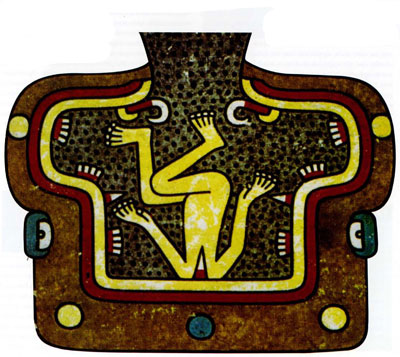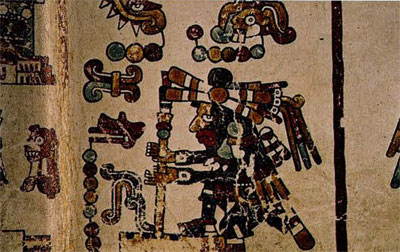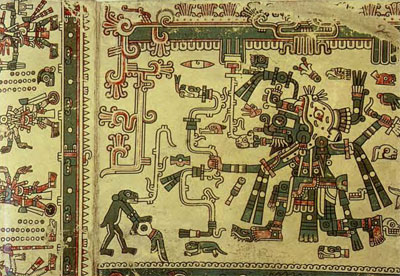
Forget grubs, sheep’s eyes, and moss; the ultimate in exotic culinary experience must surely be the eating of human flesh. Pork most closely resembles it in taste and texture, said the Aztecs of Central Mexico, who before the arrival of the Spanish in 1519 were enthusiastic practioners of cannibalism, and who in the 1520s received domesticated pigs from the Spanish invaders. The similarities probably reflect the diet of swine, which, like people, are omnivores and lack the delicate flavor of grain-, roughage-, and flower-fed animals or the gamey bouquet of carnivores. Both species exercise just enough to keep some muscle tone but not so much as to be all gristle.
While there is no doubt that the Aztecs were cannibals they readily admitted it to Spanish chroniclers — they had strict rules about when human flesh could be eaten, who could be consumed, and who were to be the guests at the banquets that occurred in the annual cycle of agricultural rituals. They did not practice a culinary free-for-all in which anyone could unexpectedly end up as the piece de resistance. Nor did they gluttonously inhale every single morsel of the body. Instead, consumption of another person was intimately tied to ideas of transforming human flesh into a highly potent substance that conveyed life force and that could be eaten only by other people who were already halfway to being gods themselves.
Banqueting Occasions
In the decades before the Spaniards arrived, the Aztecs had integrated the consumption of human flesh into a complex set of rituals tied to the 365-day agricultural year. Through costume they transformed their victims into beings that personified food and useful plants, the earth in the cycle from sowing to harvest, or game animals. In one rite, for example, two Aztecs carried a sacrificial victim with arms and legs tied over a long pole, as if he were a deer. Later in that ceremony, noble participants ate small pieces of the man’s body. Occasionally, priests dressed the victims as enemies from the Aztec past, and ritually defeated them again. Usually, the Aztecs treated their victims as honored guests and adorned them in the raiment of the gods, which brings us to the question of who could be so dressed, altered into a spirit, and then eaten.
Who was the Entree?
The Aztecs rarely ate, or sacrificed, one another. For a few rituals, they chose victims from their own number, but these required special signs of supernatural selection and such individuals were difficult to find. For example, they sacrificed children in the springtime during times of drought, but only if those youngsters had two cowlicks. Instead, the intended victim was usually a captive or slave taken in battle or purchased for the occasion. In the former instance, a brave warrior subdued a prisoner and returned with him to the Aztec capital of Tenochtitlan, where he sometimes fed and housed his captive until the time of sacrifice. The purchase of an appropriate human offering required a sizeable outlay of resources that ordinary farmers, fishermen, or small merchants could not hope to amass.

Men of noble status with access to land and wealth sometimes sponsored a human sacrifice for the benefit of the entire city. Or an unfortunate victim might be acquired by a wealthy merchant, one of the Tenochtitlan (traveling traders) who were in the process of becoming highly influential in Aztec economic, social, and political life when the Spanish arrived. Other native peoples in Mexico feared and suspected the pochteca because they also served as spies for the expansionist Aztec empire. The pochteca often disguised themselves to trade (and spy), lest their enemies seize and kill them. Old merchants warned the young not to leave captured comrades behind to fill an enemy’s cooking pot. Merchants often had to fight their way out of hostile villages, and many never returned home. Whether captured or purchased, the sacrificial victims were people from outside Aztec society. Often, they did not speak the language or know the customs, and they had no kin to speak up for their lives.
Tonalli, The “Life Force”
The Aztecs considered the human body to be equivalent to corn. Modern speakers of Nahuatl, the language of the Aztecs, still assert that maize is their blood, or they philosophically note that they eat the earth (and its products), and then the earth eats them. This is no fanciful idea; it is based on the observation that corn was (and remains) the adult dietary staple. The pre-Columbian peoples ground it into meal to drink as atole, and often flavored it with fruit or honey. They ate cornmeal as tamales and probably as tortillas. They added honey, seeds, and juices, and formed it into small figurines, cakes, S shapes, miniature objects, and human body parts. They consumed it at least once a day. Of what other substance could the human body be made, except edible maize?
To eat a man or woman was to take flesh composed of corn, which, in turn, captured and contained the radiant heat of the sun. In any source of heat, the Aztecs detected a basic life force in the universe, called tonally. The hearth fire, flaming lava flows, a thick blanket or cloak, sunlight, and living bodies generated it. The Aztecs said that a pair of aged gods, who lived in the heavens, took a fire drill, and twirled the upright stick in the chest of an unborn child. Thus was the vital heat ignited. Conversely, the dead were cold to the touch and lacked any life force. At the beginning of all things, the gods gave their own life force to the sun, so that eating a human being was tantamount to consuming the tonally of the gods, which sustained the sun that gave heat to the corn.
Things or processes that we classify as inanimate also contained tonally, according to the Aztecs. The life force was especially present in objects that could renew themselves: hair, fingernails, the first teeth of children that were shed and replaced, and feathers used to decorate shields, headdresses, and capes. Shaping precious gemstones also produced friction and heat. Lapidaries drilled holes in the center of jade, crystal, and turquoise ornaments to suspend them, warming the stones and giving them tonally. Hereditary, military, and financial elites placed their costumes and accouterments jewelry, feather shields and headdresses, and cloaks and tunics — in the sun to recharge their life force.
Two final points about the tonally: In addition to heat, it was also reflected in status, and it conferred social identity. The more capable a person in any field, the greater his or her tonally. Noble warriors possessed more life force than common foot soldiers, and expert craftsmen more than indifferent workers or apprentices. Some people had greater tonally by dint of birth. Nobles naturally had more vital power than commoners, and the Aztec ruler, or emperor, was filled with more than nobles. The amount of internal tonally, the Aztecs believed, was properly expressed in external appearance. The wealthier, the more powerful, the stronger, or the more capable the person, the finer were his clothes and jewelry. No common laborer could hope to wear an elegant quetzal feather, even if he found one in the road. His tonally was not sufficiently strong to match such an ornament.
The logic of human sacrifice, and cannibalism, rested on the exchange of tonally. For sacrifice, the Aztecs transformed a mere human being, the possessor of a modest amount of life force, to a more powerful image — usually of a deity by dressing the captive in jewels, feathers, and costumes during the ritual. The insignificant individual assumed the appearance of a god, and with it, the deity’s vital force. The difference between human and “divine” being was in large part a difference in the amount of tonally that each contained.
Pre-Columbian Codices
The typical pre-Columbian manuscript was not truly a codex, that is, a work bound on one side, as are our modern books and magazines. Instead, an ancient Mexican book usually began as a long strip of animal (often deer) hide, pounded into a thin sheet, cut, and sewn to other sheets of the same width. After the artist rubbed the long strip with sizing to make it stiff and polished it to make it smooth, it resembled in weight and surface the parchment and vellum, also made of animal hide, used by western medieval manuscript painters. Then the artist measured his work and painted his narrative in pictures. Finally, he folded the long strip back and forth, accordion-style, to form separate pages. This format yielded a screenfold pictorial manuscript that is usually, but erroneously, called a codex.
Some of the pre-Columbian codices originated in the Mixtec, an area that is now predominantly in the state of Oaxaca, Mexico. Mixtec manuscripts were primarily concerned with genealogies and deeds of local rulers, while Codex Vindobonensis Mexicanus 1 presents the foundation of these ruling lineages in the ancient First Times.They reflect the language, culture, and rituals of the elite Mixtec people. Other pre-Columbian books, including Codex Laud, present calendrical and divinatory information and chronicle journeys of the spirits to the underworld and various sacred sites.The provenance of these works is still under debate, but they have affinities to both Mixtec and Central Mexican Aztec themes and deities.
The Maya people developed a form of written glyphic script, but the Mexican screenfold manuscripts convey their stories entirely in pictures. Neither the Mixtec nor the Aztecs invented script, and any words that appear in the non-Maya codices were added by Europeans. Apparently the manuscripts served as devices to remind the reader of the correct sequence of information.
Guests at the Banquet
The emperor, nobles, and high-ranking soldiers were the most consistent consumers at cannibalistic rites. Occasional guests included warriors or merchants, and especially the men who provided the human sacrifice, and their families. In public, the emperor dressed splendidly in intricately woven clothing, magnificent jewelry in precious stones and gold, and iridescent quetzal feathers as evidence of his strong tonally. Nobles, the Aztecs believed, had tonally different from that of ordinary men and women. They, too, were granted special, rich clothing, as were warriors who had proven the strength of vital powers through their bravery and survival of many battles. Only those who already possessed great tonally could expect to receive additional life force. Their vital powers placed them between the average human being and the spirits, and like the gods, they were fortified with the tonally of others.
After death, the Aztecs said, the character of an individual’s tonally was clearly revealed. Out of the body, the vital forces of common men and women became weasels, skunks, or other smelly animals with unsavory habits. Those of nobles transformed into the mists and fogs that brought life-giving rains of the wet, agricultural season. Nobles achieved the status of deities after death. They did not just become dead ancestors but in essence revealed their natures as life-sustaining rain gods.

On one level, human flesh was part of a natural cycle. The sun gave warmth, and the corn sealed its energy in juicy kernels. Then people ate maize and turned it into flesh. In exchange, the Aztecs, common and noble, often offered their blood (which they believed carried tonalli) to the gods, to replace the life force that the deities originally gave to the sun and to replace the life force the sun showered onto the earth.
A costume, rich jewelry, and feathered ornaments transformed a human being into the living image of a god by adding to his or her tonally. Nobles, and sometimes valiant warriors and wealthy merchants, consumed part of that tonally-charged body, because high-status people were already tonally-rich. After their deaths, although their noble bodies might also be eaten by the earth, their tonally transformed into rain clouds and mists. In the wet season, their life forces thundered across the wide Valley of Mexico, watering it and making the plants, and especially the maize, bloom and grow.
If a common man could not join a ritual meal of human flesh, he could hope that the tonally of the nobles — future rain spirits — would be fed and grow strong. In the ritual consumption of flesh, the human body was no longer present. Instead, the near, or soon-to-be, god ate the image of the god, as the living nobles gained vital power that they would use after death for the benefit of everyone.
Acknowledgments
Jill Leslie McKeever Furst is professor of art history at Moore College of Art and Design and is consulting scholar in the American Section of the University of Pennsylvania Museum of Archaeology and Anthropology. She is author of The Natural History of the Soul in Ancient Mexico and Mojave Pottery/ Mojave People and is coauthor of North American Indian Art. She is currently working on a book about Aztec rain gods.
